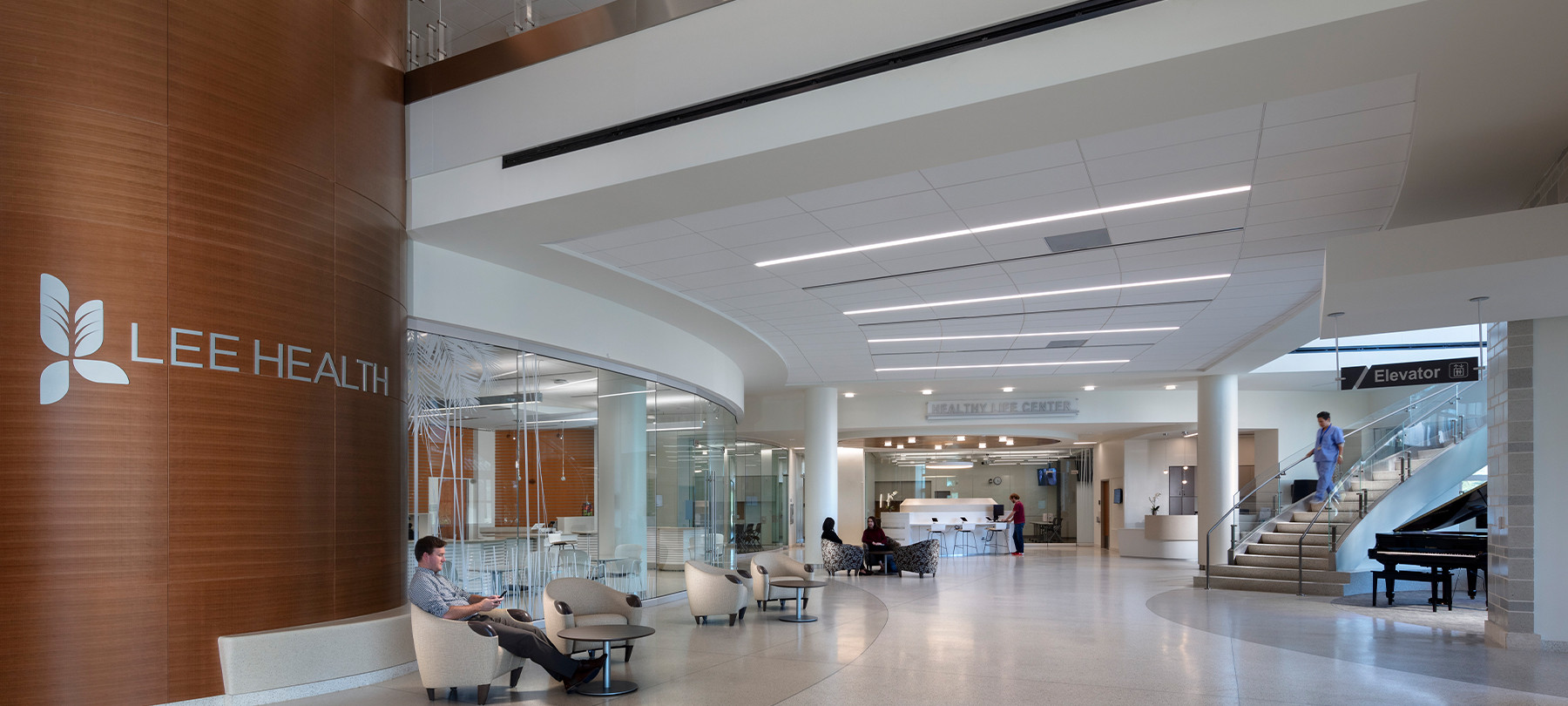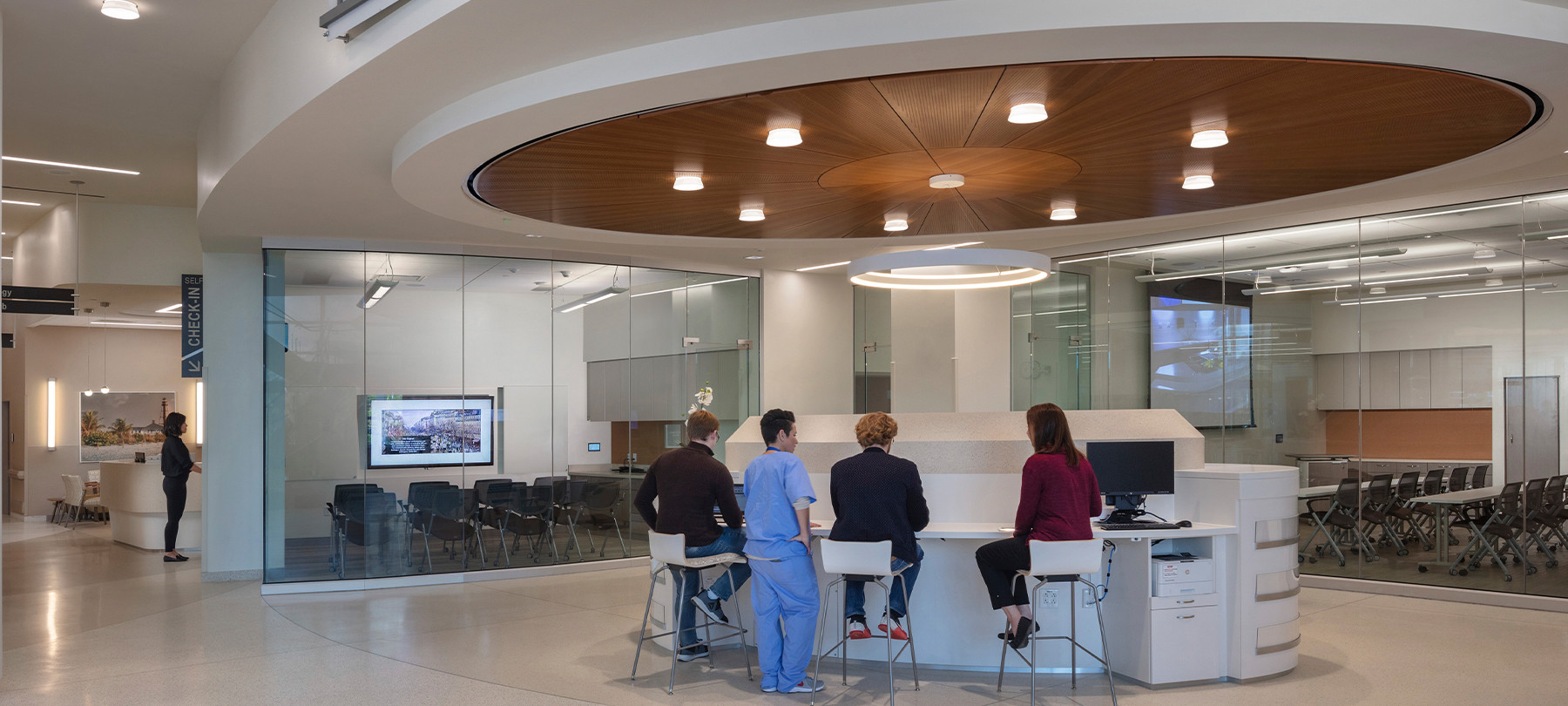
Creating Our Own Crystal BallThe immediate future changed dramatically since the start of the COVID-19 pandemic, and it has challenged healthcare deeply on many levels – how to keep patients safe, administer best-in-class care, and repurpose care settings as needed overnight. Almost two years later, learning continues daily. With such radically changing care delivery demands, facility needs, and safety requirements, how can health systems anticipate and plan for future needs and rethink current facilities in time to keep pace with these expansive shifts?
As we move forward implementing necessary adjustments due to virus variants and making plans for the next pandemic, health systems and caregivers must continue to respond practically and without pause.
Envisioning the Future of Healthcare
Creating Our Own Crystal BallThe immediate future changed dramatically since the start of the COVID-19 pandemic, and it has challenged healthcare deeply on many levels – how to keep patients safe, administer best-in-class care, and repurpose care settings as needed overnight. Almost two years later, learning continues daily. With such radically changing care delivery demands, facility needs, and safety requirements, how can health systems anticipate and plan for future needs and rethink current facilities in time to keep pace with these expansive shifts?
As we move forward implementing necessary adjustments due to virus variants and making plans for the next pandemic, health systems and caregivers must continue to respond practically and without pause.
It is helpful to investigate some of the core changes in care encounters, how they changed because of the coronavirus pandemic, and the potential implications of what have we learned. Previously unforeseen changes are clearly in motion and others will evolve over the coming months and into the foreseeable future. Here are three current knowns:
- Telehealth is here to stay. Virtual and telemedicine engagement will be present and more commonplace for different types of encounters. Health systems broke all past records for telehealth and virtual care encounters since March 2020 and learned a lot about how to do it better. Reimbursement uncertainty still makes the extent of this mode of care hard to predict, but there is indisputable data to suggest that more care will be administered this way, barring a significant reimbursement challenge. Additionally, use of technology apps for healthcare monitoring has grown by leaps and bounds and will continue this pace given investments in this sector and escalating patient acceptance and demand.
- Infection Control and Prevention (IPC) planning must occur earlier in the design process. Including IPC planning in a project's early stages is clearly the way forward. New wearables, robots, and automation technology is being developed faster than ever, allowing the ability to automate more tasks in a variety of healthcare settings.
- New entrants to the care landscape are reinventing primary care. These new providers are technology powerhouses aggressive about ramp-up and ease of access for patients.
Taking a closer look at these three knowns with a real-world example of how a large health system responded to explosive overnight demands for telehealth and evolving technology-enabled convenience can help inform planning for new day-to-day care norms.
A Case Study in Telehealth Migration, Rapid Transition, and Integration //

Lee Health, Fort Myers, Florida
Lee Health is the largest not-for-profit health system in Florida with over one million patient contacts each
year. Though they previously embraced the use of telehealth at some level for several years prior to COVID-19,
Dave Kistel, Lee Health's Vice President of Facilities and Support Services, estimates that, out of necessity,
the pandemic likely thrust the system five years ahead within a one-year time span.
Lee Health's accommodation of soaring demands for telehealth began, unsurprisingly, in March 2020. Their data shows a startling increase in use from 1,000 telehealth encounters over a five-month period to 100,000 encounters in record-breaking time. In addition, pre-pandemic, Lee had around 100 providers trained in telehealth delivery across eight departments. These numbers ballooned to 1,000 trained providers in over 60 departments between March and August of 2020.
With increased usage and the convenience of telehealth, Lee Health took full advantage of technologies in place and enhanced their platform and infrastructure to appropriately handle the demands for this mode of patient care delivery. Notably, Lee utilized Caregility's two-way audio and video platform for healthcare settings which integrates with Epic via context-aware linking, thereby tying together a HIPAA-compliant, flexible, and secure video conference tool within various clinical workflows.
What Lee Health discovered aligns with broader industry trends – ease of use for both ambulatory and inpatient environments is key. With these integrated platforms, Lee Health's patients have access to virtual sessions on the cloud from any device with no secondary app download required. Both scheduled and on-demand visits can be launched for patients with or without MyChart. The platform also includes an integrated language translator which seamlessly increases accessibility and ease of use for all patients.
Benefits also extend to health systems. Organizations can scale up or down telehealth session capacity based on usage needs with uncapped session license capacity. For documentation and coding, providers can use both telehealth and E&M codes, which integrate with Epic's charge capture functions. Finally, health systems can combine these platforms with telehealth hardware devices, which come in different forms ranging from wall-mounted, mobile/fixed carts to tablets; enabling multiple clinical workflows in various environments.
The Ever-increasing Importance of Early IPC Planning and Adaptation of New Technology //

The focus of infection control planning has traditionally been on mitigating healthcare-associated infections and protecting staff safety. Typically, IPC planning is addressed during the later planning stages of schematic design and design development; however, including IPC planning in the early planning stages of master planning and programming, during which high-level decisions are made, is the way forward for reduced cross-contamination and a built-in surge capacity plan.
Considerations for IPC during master planning should include entry points, circulation, segregation, surge capacity, and ventilation systems. For surge capacity and scalability, it will be particularly important in future planning to require areas designated to receive, triage, and treat large groups during unplanned events. Advanced planning and coordination of utility services, supplies, and connectivity are also vital considerations. For example, early engagement in MEP (mechanical, electrical, and plumbing) provisions should include planning for negative pressure environments to help control the spread of infection particles; offer provisions for redundant power; and address infection control concerns for normal operations and unplanned events, such as a civil emergency.
As for technology, there has been a steady influx of new IPC technology to address infection prevention and control, and in light of recent events, we expect to see this rapid escalation continue. As one example, Biovigil offers wearable badges with red, yellow, and green lights to remind and support hand hygiene compliance. Robots with continually improving technology are frequently used in hospitals to automate numerous tasks. In material handling and environmental services, automation is used to move large volumes of material daily, including linens, medication, equipment, patient meals, clean supplies, waste, and recyclables. Originally used exclusively to transport clean supplies and waste, automation is now also being used for UV-C (ultraviolet-C light) sanitization to clean floors and even to greet and remind people to wear masks and social distance inside facilities.
Integration of automation is a growing trend in healthcare, resulting in increased efficiency. The efficacy and safety of new technologies for sterilization and sanitization is not clear, and hospitals have been slow to adopt some of the newer methods. Technology is being introduced at a faster pace than at any other time in our history, and as such, the process of vetting new technologies and raising awareness of its possibilities has not yet caught up.
Tech Giants Shaking Things Up // In order to compete with the tech-based organizations that have migrated to deliver patient care, traditional health systems must rapidly advance transitions in their care model. Who are these new entrants to the marketplace and how are they shaking things up? No trivial threat to health systems, tech giants like Amazon, Apple, and Google are each in various stages of developing health clinics for employees, online pharmacies, and wearable devices connected to digital health apps that can monitor health conditions around the clock and communicate data instantly to providers.
Organizations that do not develop training, tech platforms, tech infrastructure, and provider support may be left behind by these large, tech-based organizations that can mobilize faster with new primary care providers. Healthcare planners and strategists must consider how best to support consumers who are increasingly assuming the driver's seat in their own care.
Patients have become accustomed to remote access to care data; fewer boundaries and time restrictions around care; and wearables, digital health apps, and embedded sensors. The sooner health systems embrace this new reality – focused on efficiencies, patient experience, and technological advancement – the better they will be able to remain competetive in a rapidly evolving and expanding field.
In summary, when forecasting the future of healthcare delivery, all signs point to a focus on whole-health thinking and reinventing care spaces as we know them.
Conclusion and Key Takeaways //Facility Planning Opportunities: A Futuristic Lens
As healthcare
planners look to the future and imagine what is and is not in place today, we must innovate
real-time, flexible solutions and anticipate continually expanding use of technology in care delivery.
In the built environment, planners and providers must challenge previous assumptions and consider new
flows of staff, patients, and materials. Highly flexible, adaptable spaces are more vital than ever to
support changed behaviors, operational protocols, potential future pandemic pathogens with varying modes of
transmission (e.g., direct contact, airborne, ingestion, vector-borne), and the incorporation of new
technologies and patient expectations.
Traditional spaces will continue to change and evolve drastically. With a potential reduction in physical primary care encounters, some patient rooms can be converted to provider telehealth care rooms (including those for groups). Rooms could also be converted to house enabling technology infrastructure and/or multiple devices and equipment for telehealth and multi-site team interaction. Additionally, technology education resource centers will become standard, accessible, and visible in care settings.
Lessons learned throughout this time are likely to lead to the development of modular, interchangeable rooms and isolation units, with isolation-focused MEP infrastructure, for just-in-time response. As part of this, safety and anteroom spaces may be incorporated into new facility plans for changing, gowning, and support. Acceptable space density and capacity metrics will be developed by regulators and applied to new construction, renovations, and repurposed space.
The Bottom Line We need to plan space that will support in-person and virtual encounters; imagine how to repurpose available space quickly (especially ambulatory spaces); and offer physical plans that can flex and change, at the highest level of adaptation, with minimal cost.